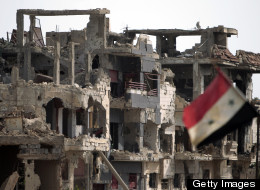 TWO YEARS ago this week, protests erupted against the Syrian regime of Bashar al-Assad in Damascus and the southern city of Daraa. Since then, two unchanging factors have propelled the most horrific bloodshed to take place in the Middle East since the beginning of the Arab revolutions. One is the absolute and ruthless determination of the Assad regime and its allies in Iran to crush the rebellion by force alone. The other is the reluctance of the United States to recognize that reality and respond accordingly.
TWO YEARS ago this week, protests erupted against the Syrian regime of Bashar al-Assad in Damascus and the southern city of Daraa. Since then, two unchanging factors have propelled the most horrific bloodshed to take place in the Middle East since the beginning of the Arab revolutions. One is the absolute and ruthless determination of the Assad regime and its allies in Iran to crush the rebellion by force alone. The other is the reluctance of the United States to recognize that reality and respond accordingly.
From the first days of demonstrations, when unarmed civilians marched through streets chanting, “Peaceful, peaceful,” the regime responded with murder. First came gunfire directed at the marchers; then indiscriminate artillery barrages and tank assaults against residential neighborhoods; then bombing by warplanes; then the firing of Scud missilesinto cities.
From the first days of demonstrations, when unarmed civilians marched through streets chanting, “Peaceful, peaceful,” the regime responded with murder. First came gunfire directed at the marchers; then indiscriminate artillery barrages and tank assaults against residential neighborhoods; then bombing by warplanes; then the firing of Scud missilesinto cities.
While this was going on, the Obama administration at first labeled Mr. Assad “a reformer” and suggested he would end the rebellion by offering political change; then backed months of feckless U.N. cease-firediplomacy, which the regime cynically manipulated; then bet on the notion that Russia, a close Syrian ally and arms supplier, would somehow force Mr. Assad to leave office, despite Vladimir Putin’s well-known antipathy to Western-engineered regime change. In short, an administration that prides itself on its foreign-policy “realism” subscribed to one fanciful scheme after the next, all while ignoring the warnings of Syrians and its own Middle East experts that there was no chance of success — and that time to prevent a catastrophe was running out.
The product of this confluence of brutality and bad judgment has been the tragic transformation of what was once a mass pro-democracy movement. First the peaceful marchers morphed into disorganized groups of fighters, then to increasingly hardened and radicalized militias — of which one of the strongest isan affiliate of al-Qaeda. One of the Middle East’s most strategically important countries has been wrecked. There are now nearly 1 million Syrian refugees in neighboring countries, and many of those left in the country are desperately short of food and medical care.
A year ago, when Syrian deaths were estimated at 7,000 and al-Qaeda had yet to establish a foothold, President Obama objected to proposals for U.S. intervention on the grounds that it could lead to the militarization of the conflict or play into the hands of extremists. Today the extremists are ascendant, the fighting is spilling over into Iraq and Lebanon, and the estimated death toll surpasses 70,000. Yet the administration persists in its wishful thinking and defeatist excuse-making. It has announced plans to channel small amounts of nonlethal aid to some rebel forces on the expectation that this will “change Assad’s calculations” and prompt him to step down.There are reports of a modest covert operation to train some rebels. But the administration refuses to encourage the establishment of a full-fledged alternative government on the grounds that this might interfere with a moribund U.N. plan for negotiations.
As from the start, it’s relatively easy for Syrian realists to see where the conflict is going. Most likely, as the regime slowly loses ground to the rebels, Syria will crack into pieces controlled by rival authorities — including a regime remnant in Damascus or along the Mediterranean coast, backed by Iran, and an al-Qaeda-controlled zone along the border with Iraq. Fighting along sectarian lines, and between extremist and moderate Sunnis, will continue to spread into Lebanon and Iraq, destabilizing both those countries. Eventually the regime may resort to using chemical or biological weapons or attempt to transfer them to its Lebanese or Iranian allies.
It has been 18 months since Mr. Obama first claimed that time was running out for the Assad regime. Now it is running out for him. His continued refusal to intervene in Syria will invite an even greater catastrophe that will indelibly stain his presidency.
THE means to prevent this implosion are the same that could have stopped the ignition of the civil war: aggressive intervention by the United States and its allies to protect the opposition and civilians. This would not require ground troops, only more training and the supply of heavy weapons to the rebels, and airstrikes to eliminate the regime’s warplanes, missiles and, if necessary, chemical weapons. The recognition of an alternative government led by the civilian Syrian National Coalition would send the message to wavering regime supporters that it was time to defect and would help to isolate al-Qaeda before it is too late.
Several of Mr. Obama’s top advisers pressed him to consider such measures six months ago. Key U.S. allies, including Britain, France, Turkey, Saudi Arabia and Israel, have quietly pleaded with the White House to act. It has been 18 months since Mr. Obama first claimed that time was running out for the Assad regime. Now it is running out for him. His continued refusal to intervene in Syria will invite an even greater catastrophe that will indelibly stain his presidency.
Washington Post editorial
Leave a Reply
You must be logged in to post a comment.